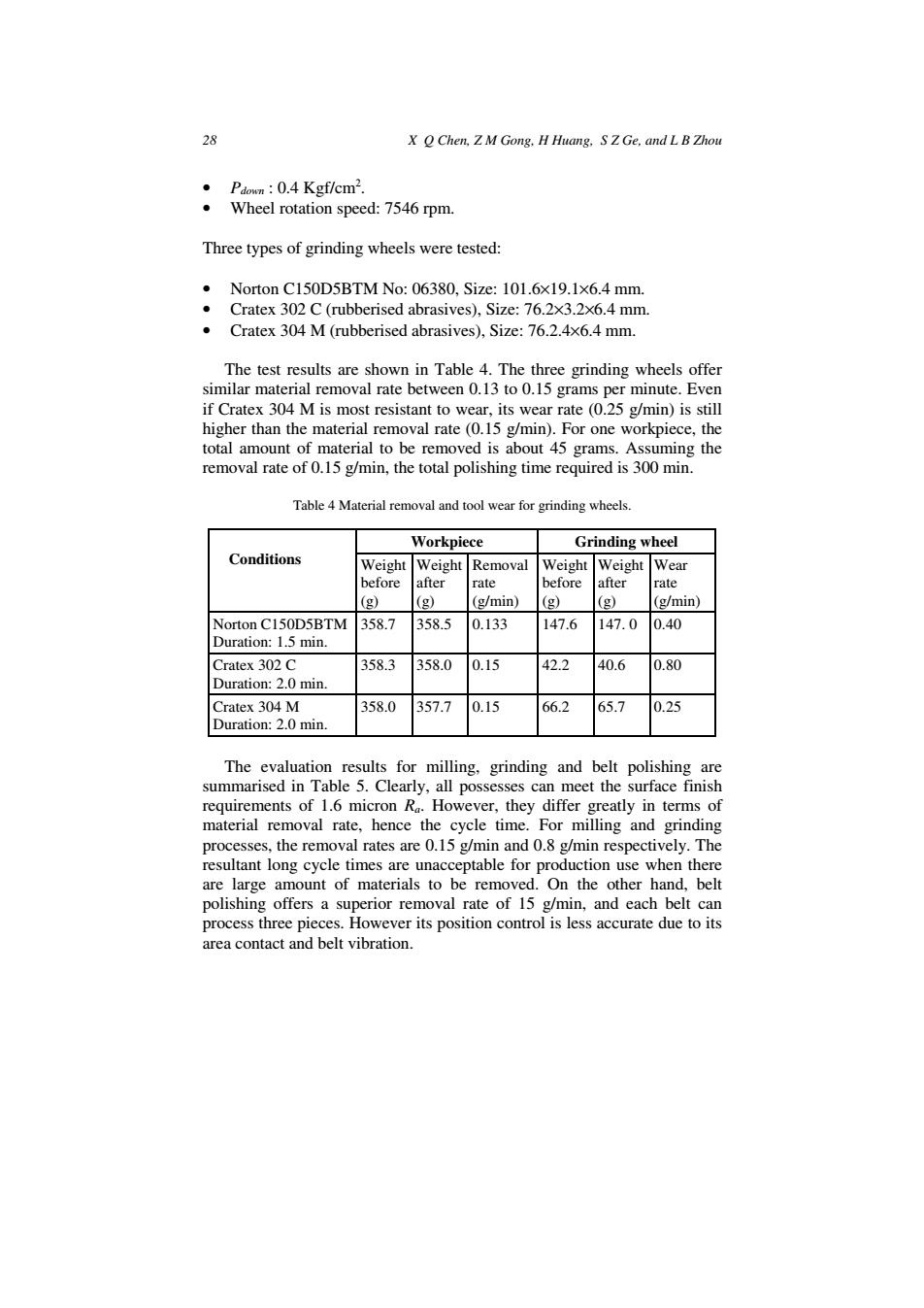正在加载图片...

28 X O Chen,Z M Gong,H Huang,S Z Ge,and L B Zhou ·Pdown:0.4 Kgf/cm2. Wheel rotation speed:7546 rpm. Three types of grinding wheels were tested: .Norton C150D5BTM No:06380.Size:101.6x19.1x6.4 mm. Cratex 302 C(rubberised abrasives),Size:76.2x3.2x6.4 mm. Cratex 304 M (rubberised abrasives),Size:76.2.4x6.4 mm. The test results are shown in Table 4.The three grinding wheels offer similar material removal rate between 0.13 to 0.15 grams per minute.Even if Cratex 304 M is most resistant to wear,its wear rate (0.25 g/min)is still higher than the material removal rate (0.15 g/min).For one workpiece,the total amount of material to be removed is about 45 grams.Assuming the removal rate of 0.15 g/min,the total polishing time required is 300 min. Table 4 Material removal and tool wear for grinding wheels. Workpiece Grinding wheel Conditions Weight Weight Removal WeightWeight Wear before after rate before after rate (g) (g) (g/min) (g) (g) (g/min) Norton C150D5BTM 358.7 358.5 0.133 147.6 147.0 0.40 Duration:1.5 min. Cratex 302 C 358.3 358.0 0.15 42.2 40.6 0.80 Duration:2.0 min Cratex 304 M 358.0 357.7 0.15 66.2 65.7 0.25 Duration:2.0 min The evaluation results for milling,grinding and belt polishing are summarised in Table 5.Clearly,all possesses can meet the surface finish requirements of 1.6 micron Ra.However,they differ greatly in terms of material removal rate,hence the cycle time.For milling and grinding processes,the removal rates are 0.15 g/min and 0.8 g/min respectively.The resultant long cycle times are unacceptable for production use when there are large amount of materials to be removed.On the other hand,belt polishing offers a superior removal rate of 15 g/min,and each belt can process three pieces.However its position control is less accurate due to its area contact and belt vibration.28 X Q Chen, Z M Gong, H Huang, S Z Ge, and L B Zhou • Pdown : 0.4 Kgf/cm2 . • Wheel rotation speed: 7546 rpm. Three types of grinding wheels were tested: • Norton C150D5BTM No: 06380, Size: 101.6×19.1×6.4 mm. • Cratex 302 C (rubberised abrasives), Size: 76.2×3.2×6.4 mm. • Cratex 304 M (rubberised abrasives), Size: 76.2.4×6.4 mm. The test results are shown in Table 4. The three grinding wheels offer similar material removal rate between 0.13 to 0.15 grams per minute. Even if Cratex 304 M is most resistant to wear, its wear rate (0.25 g/min) is still higher than the material removal rate (0.15 g/min). For one workpiece, the total amount of material to be removed is about 45 grams. Assuming the removal rate of 0.15 g/min, the total polishing time required is 300 min. Table 4 Material removal and tool wear for grinding wheels. Conditions Workpiece Grinding wheel Weight before (g) Weight after (g) Removal rate (g/min) Weight before (g) Weight after (g) Wear rate (g/min) Norton C150D5BTM Duration: 1.5 min. 358.7 358.5 0.133 147.6 147. 0 0.40 Cratex 302 C Duration: 2.0 min. 358.3 358.0 0.15 42.2 40.6 0.80 Cratex 304 M Duration: 2.0 min. 358.0 357.7 0.15 66.2 65.7 0.25 The evaluation results for milling, grinding and belt polishing are summarised in Table 5. Clearly, all possesses can meet the surface finish requirements of 1.6 micron Ra. However, they differ greatly in terms of material removal rate, hence the cycle time. For milling and grinding processes, the removal rates are 0.15 g/min and 0.8 g/min respectively. The resultant long cycle times are unacceptable for production use when there are large amount of materials to be removed. On the other hand, belt polishing offers a superior removal rate of 15 g/min, and each belt can process three pieces. However its position control is less accurate due to its area contact and belt vibration